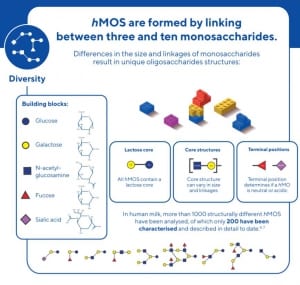
Kabrita’s goat milk naturally contains oligosaccharides
Another beneficial asset of goat milk based formula is the natural presence of oligosaccharides. Oligosaccharides are a type of carbohydrate formed when three to 10 simple sugars are linked together. Oligosaccharides can be found as fibre in plant foods. Since the digestive system cannot break these down, 90% of these oligosaccharides reach the colon intact. Here, oligosaccharides can act as prebiotic which is defined as “a selectively fermented ingredient that results in specific changes in the composition and/or activity of the gastrointestinal microbiota, thus conferring benefit(s) upon host health”.1
Human milk oligosaccharides
Human milk oligosaccharides (hMOS) are the third largest component of human milk after lactose and fat.2,3
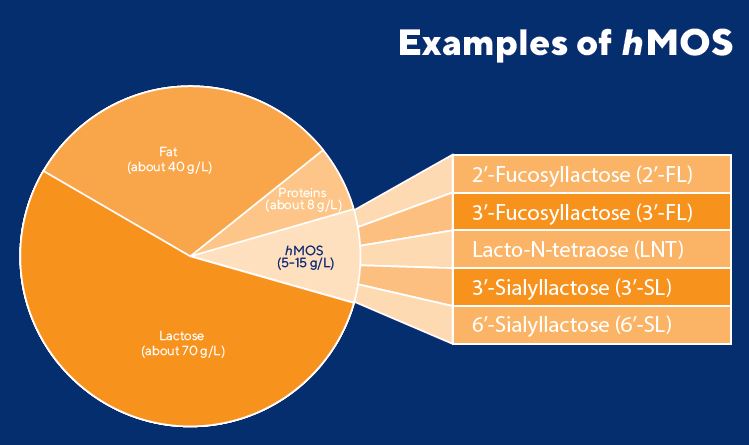
The highest concentration of hMOS is reported in colostrum, with levels up to 20 g/L or more, while mature human milk has levels ranging from 5 to 15 g/L.4,5 The levels of hMOS vary and are influenced by the period of lactation as well as by genetics.5,6 Human milk contains a high diversity of hMOS based on their molecular structures. The differences in chain length, in composition (linear or branched) and in terminal positions form unique hMOS.2,3 In human milk, 247 structurally different hMOS have been found, of which only 162 have been characterized and described in detail to date. Twenty-two hMOS structures are defined as major structures, which means that these hMOS are responsible for > 95% of the total amount of hMOS.7 The most abundant hMO is 2’-fucosyllactose (2’-FL).
Click on the infographic below for a quick overview about the diversity, amount and functionality of hMOS

Function of hMOS
The individual hMOS structures might have different mechanisms of action, functions and health benefits.8 The high diversity of oligosaccharides in human milk highlights the need for a diverse mixture of oligosaccharides in infant formula to resemble the human milk composition and functionality more closely.8,9

hMOS have been shown to function as prebiotic by developing a well-balanced gut microbiota. However, hMOS can also have direct effects on the gut wall and immune system:
• hMOS are hardly digested in the small intestine, but are metabolized by the bacteria in the large intestine. hMOS are favoured substrates for specific gut bacteria and promote the growth of beneficial bacteria such as the bifidobacteria and lactobacilli. Breastfed infants indeed have a well-balanced gut microbiota dominated by bifidobacteria, mainly due to the high levels and diversity of hMOS.8
• By modulating the beneficial bacteria, hMOS in turn inhibit the growth of pathogenic bacteria. hMOS can act as a decoy for pathogenic bacteria to the gut wall, inhibiting the binding of such pathogenic bacteria. hMOS can interact with the gut epithelial cells, resulting in glycan expression in the gut wall. Glycan can also prevent the binding of pathogenic bacteria to the gut wall.9
• During the metabolism of the hMOS by the gut bacteria, by-products such as short-chain fatty acids are formed. These short-chain fatty acids can serve as nutrients for the gut epithelial cells, strengthening the gut barrier functioning.10 hMOS also directly strengthen the gut wall by the production of glycans.8
• As hMOS prevent pathogens from binding to the gut wall, the immune system is influenced and infections could be prevented and subsequently illness.11,12 hMOS are also described as being able to modulate the immune cell functions in positive ways. hMOS shift the response towards a t-helper 1 (th1) response, favouring the development of an adequate and balanced immune response.8
Several mechanisms have been described by which hMOS affect the gut microbiota, gut wall and immune function. However, the number of these studies is still limited. Further research on the functioning of individual hMOS structures is also warranted as most studies investigated the functioning of a combination of oligosaccharides.8
Levels and diversity of hMOS
Human milk contains relatively high levels and a high diversity of oligosaccharides with proven beneficial effects for infants. To offer formula-fed infants the benefits of hMOS, an infant formula should preferably mimic the level, diversity and function of hMOS. Infant formula can be supplemented with prebiotics such as galacto-oligosaccharides (GOS) or fructo-oligosaccharides (FOS) in order to promote the growth of bifidobacteria and lactobacilli. However, these two oligosaccharides have another molecular structure (no terminal fucose or sialic acid residues), hence miss some beneficial functions of hMOS.8
The re-synthesis of the diversity of oligosaccharides in human milk is extremely difficult. However, oligosaccharides can also be derived from mammalian milk.13 Goat milk is a good and natural source of oligosaccharides offering beneficial effects to infants.
Goat Milk Oligosaccharides
Goat milk is reported to have one of the highest levels of oligosaccharides compared to milk from other domestic animals.7 More information can be found in our review paper, in collaboration with Carbexplore and University Medical Center Groningen.
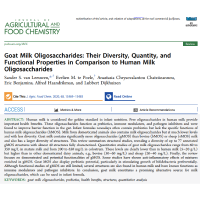
Paper: goat milk oligosaccharides (van Leeuwen et al 2020)
Kabrita’s goat milk, which is the fresh goat milk used to produce Kabrita formula, has 6 times higher oligosaccharide levels compared to cow’s milk (Kabrita’s goat milk: 0.22 g/L, cow’s milk: 0.04 g/L.14 Human milk has much higher levels than levels in mammalian milk (5-15 g/L).14 In the figure below, the total levels of oligosaccharides in Kabrita’s goat milk and cow’s milk are shown.
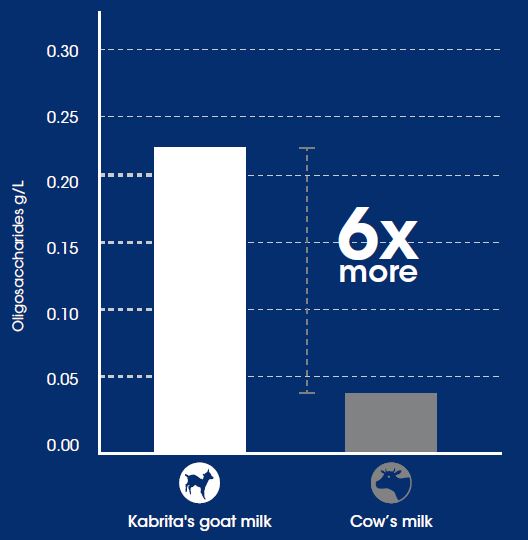
The levels of goat milk oligosaccharides (gMOS) vary between distinct goat breeds and is dependent on many factors such as the age of the goats, lifelong milk production, number of goat pregnancies and farm feeding.7,15
Several gMOS identical to hMOS

Not only are the levels of oligosaccharides in goat milk higher than in cow’s milk, but also the diversity in oligosaccharide structures. Goat milk has already been seen to have the oligosaccharide profile more similar to human milk than cow’s milk with human milk.7 In Kabrita’s goat milk, 21 different oligosaccharide structures could be analysed, of which 12 oligosaccharides could be characterized. Of these 12 oligosaccharides in Kabrita’s goat milk, 5 oligosaccharides are identical to hMOS. 2’-FL is one of these oligosaccharides and is present in 74% of the analysed goat milk samples, suggesting the possibility of a secretor/non-secretor goat genotype.15 More information about this research can be found in the paper below.
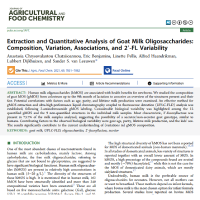
Paper: gMOS in Kabrita’s goat milk (Chatziioannou et al 2021)
Leong et al. showed that 14 oligosaccharides can be characterized in goat milk. Of these 14 oligosaccharides, 5 gMOS are identical to hMOS. In the goat milk formula (stage 1 and 2) analysed, these 14 gMOS were still present, which means that these gMOS are not influenced by the heat treatment required to produce infant formula.16
In a review publication, it was reported that 17 oligosaccharides were identified in goat milk. Six of these 17 gMOS were identical to hMOS.17Another publication concluded that these 6 oligosaccharides were identical in gMOS and hMOS.14 The differences in the number of characterized oligosaccharides can be due to differences in methodology: methodology only detecting quantifiable oligosaccharides, versus a methodology that also detected oligosaccharides in trace amounts.7,17
Health benefits gMOS
Because of the higher level and higher diversity of oligosaccharides in Kabrita’s goat milk compared to cow’s milk, goat milk is a good base for infant formula as it provides a natural source of oligosaccharides. The oligosaccharides that are naturally present in goat milk formula may offer some of the health benefits as described for hMOS.
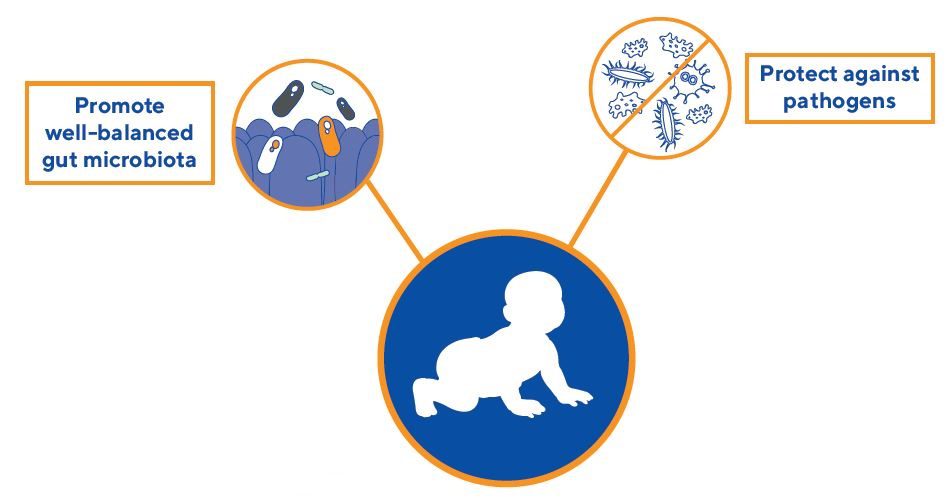
The gMOS were proven to stimulate the growth of bifidobacteria and lactobacilli and to prevent the adhesion of E. coli and S. typhimurium (pathogenic bacteria) to gut cells in laboratory tests.17 Another publication confirmed the prebiotic activity of gMOS and showed an increased growth of bifidobacteria (laboratory testing).18 gMOS were indeed proven to bind to pathogenic bacteria, thereby preventing pathogens to bind to the gut wall.19
Furthermore, gMOS were shown to have anti-inflammatory effects in rats with experimental colitis resembling ulcerative colitis in adults.20 These anti-inflammatory effects are not only due to the inhibition of pathogenic bacteria and the promotion of growth of lactobacilli and bifidobacteria, but also due to the blocking of the binding of monocytes (immune cells) to gut wall cells. By blocking this interaction, the progression of inflammatory responses could be inhibited.14
The functional properties of gMOS have been described in a limited number of publications and have mainly been tested in laboratory settings. However, the beneficial effects of goat milk infant formula on the gut microbiota was also investigated in a clinical study, showing that the gut microbiota of infants using GMF is more similar to the gut microbiota of human milk-fed infants than those of CMF-fed infants.21 This positive modulation of the gut microbiota may be due to the oligosaccharides naturally present in goat milk formula. Although there is some evidence that oligosaccharides in goat milk formula offer health benefits to infants, more (clinical) research is warranted.
Click on the infographic below for a quick overview about the diversity, amount and functionality of gMOS
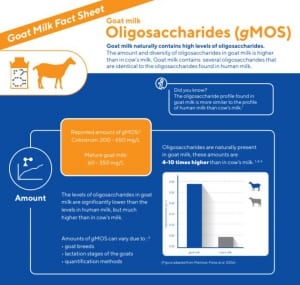
Infographic: gMOS
Natural mixture of gMOS compared to single synthetic oligosaccharides
A recent study investigated the effects of the natural mixture of gMOS on infant intestinal microbiota compared to single synthetic oligosaccharides.22 This study showed that our natural mixture of gMOS stimulates Parabacteroides and to lesser extent Bacteroides. Unlike 2’-FL and GOS, gMOS consist of a mixture of complex structures like the mixture of oligosaccharides in human milk and has a high percentage of sialylated oligosaccharides (~80%).7 Bacteroides and Parabacteroides are present in healthy breastfed infants microbiota and are known degraders of complex sugars and prefer sialylated hMOS. This presence of Bacteroides and Parabacteroides was also observed in infants fed goat milk infant formula.21 These results are in line with a recent consensus paper stating that a complex mixture oligosaccharides does not lead to a similarity with a single synthetic oligosaccharide.23
More information about this study can be found in the poster below.
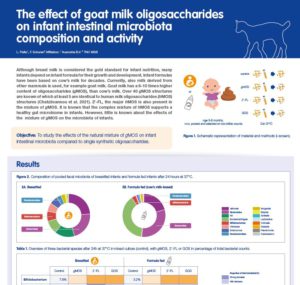
Poster: mixture of gMOS
Conclusion
> Human milk contains relatively high levels of hMOS and contains a high diversity of hMOS.
> hMOS have potential beneficial effects for infants by: promoting the growth of bifidobacteria and lactobacilli; preventing the binding of pathogenic bacteria; supporting the maturation of the gut wall; supporting the maturation of the immune system.
> Kabrita’s goat milk, goat milk used to produce Kabrita formula, naturally contains oligosaccharides: level of oligosaccharides is 6 times higher than in cow’s milk; 12 different oligosaccharide structures are characterized; 5 oligosaccharides identical to hMOS are present. 2’-FL is one of them
> gMOS increase bifidobacteria and lactobacilli levels, decrease pathogenic bacteria levels and positively modulate the immune system. More research on gMOS beneficial effects is warranted.
> A complex mixture of (goat milk) oligosaccharides does not match a single synthetic oligosaccharide
References
- 1. Gibson, G.R., et al., Expert consensus document: The International Scientific Association for Probiotics and Prebiotics (ISAPP) consensus statement on the definition and scope of prebiotics. Nat Rev Gastroenterol Hepatol, 2017. 14(8): p. 491-502.
- 2. Smilowitz, J.T., et al., Breast milk oligosaccharides: structure-function relationships in the neonate. Annu Rev Nutr, 2014. 34: p. 143-69.
- 3. Bode, L. and E. Jantscher-Krenn, Structure-function relationships of human milk oligosaccharides. Adv Nutr, 2012. 3(3): p. 383s-91s.
- 4. Ruhaak, L.R. and C.B. Lebrilla, Analysis and role of oligosaccharides in milk. BMB Rep, 2012. 45(8): p. 442-51.
- 5. Thurl, S., et al., Systematic review of the concentrations of oligosaccharides in human milk. Nutr Rev, 2017. 75(11): p. 920-933.
- 6. Coppa, G.V., et al., Oligosaccharides in human milk during different phases of lactation. Acta Paediatr Suppl, 1999. 88(430): p. 89-94.
- 7. van Leeuwen, S.S., et al., Goat Milk Oligosaccharides: Their Diversity, Quantity, and Functional Properties in Comparison to Human Milk Oligosaccharides. J Agric Food Chem, 2020. 68(47): p. 13469-13485.
- 8 Zuurveld, M., et al., Immunomodulation by Human Milk Oligosaccharides: The Potential Role in Prevention of Allergic Diseases. frontiers in Immunology, 2020. 11.
- 9. Quinn, E.M., L. Joshi, and R.M. Hickey, Symposium review: Dairy-derived oligosaccharides-Their influence on host-microbe interactions in the gastrointestinal tract of infants. J Dairy Sci, 2020.
- 10. Trompette, A., et al., Gut microbiota metabolism of dietary fiber influences allergic airway disease and hematopoiesis. Nat Med, 2014. 20(2): p. 159-66.85
- 11. Donovan, S.M. and S.S. Comstock, Human Milk Oligosaccharides Influence Neonatal Mucosal and Systemic Immunity. Ann Nutr Metab, 2016. 69 Suppl 2: p. 42-51.86
- 12. Xiao, L., et al., Early-Life Nutritional Factors and Mucosal Immunity in the Development of Autoimmune Diabetes. Front Immunol, 2017. 8: p. 1219.
- 13. Kiskini, A. and E. Difilippo, Oligosaccharides in goat milk: structure, health effects and isolation. Cell Mol Biol (Noisy-le-grand), 2013. 59(1): p. 25-30.
- 14. Martinez-Ferez, A., et al., Goats’ milk as a natural source of lactose-derived oligosaccharides: Isolation by membrane technology. International Dairy Journal, 2006. 16(2): p. 173-181.91
- 15. Chatziioannou, A.C., et al., Extraction and Quantitative Analysis of Goat Milk Oligosaccharides: Composition, Variation, Associations, and 2’-FL Variability. J Agric Food Chem, 2021. 69(28): p. 7851-7862.
- 16. Leong, A., et al., Oligosaccharides in goats’ milk-based infant formula and their prebiotic and anti-infection properties. Br J Nutr, 2019. 122(4): p. 441-449.
- 17. Kiskini, A. and E. Difilippo, Oligosaccharides in goat milk: structure, health effects and isolation. Cell Mol Biol (Noisy-le-grand), 2013. 59(1): p. 25-30.
- 18. Oliveira, D.L., et al., In vitro evaluation of the fermentation properties and potential prebiotic activity of caprine cheese whey oligosaccharides in batch culture systems. Biofactors, 2012. 38(6): p. 440-9.
- 19. Lara-Villoslada, F., et al., Oligosaccharides isolated from goat milk reduce intestinal inflammation in a rat model of dextran sodium sulfate-induced colitis. Clin Nutr, 2006. 25(3): p. 477-88.92.84. Trompette, A., et al., Gut microbiota metabolism of dietary fiber influences allergic airway disease and hematopoiesis. Nat Med, 2014. 20(2): p. 159-66.
- 20. Daddaoua, A., et al., Goat milk oligosaccharides are anti-inflammatory in rats with hapten-induced colitis. J Nutr, 2006. 136(3): p. 672-6.9385. Donovan, S.M. and S.S. Comstock, Human Milk Oligosaccharides Influence Neonatal Mucosal and Systemic Immunity. Ann Nutr Metab, 2016. 69 Suppl 2: p. 42-51.
- 21. Tannock, G.W., et al., Comparison of the compositions of the stool microbiotas of infants fed goat milk formula, cow milk-based formula, or breast milk. Applied and environmental microbiology, 2013. 79(9): p. 3040-3048.41
- 22. Pellis, L. et al., The effect of goat milk oligosaccharides on infant intestinal microbiota composition and activity. Poster at Probiotics, Prebiotics, Postbiotics in Pediatrics congress 2022.
- 22. Bührer, C., et al., Infant formulas with synthetic oligosaccharides and respective marketing practices. Mol Cell Pediatr, 2022. 13;9(1):14.



